
|
Nach den "Sicherheitsregeln für Bauarbeiten unter Tage" [BGR160], denen auch der Rohrvortrieb unterliegt, müssen Arbeitsplätze und Verkehrswege unter Tage so belüftet sein, dass: - An jeder Arbeitsstelle ein Sauerstoffgehalt von mehr als 19 Vol.-% vorhanden ist
- Die zulässige Konzentration von Gefahrstoffen in der Atemluft nicht überschritten wird
- Keine explosionsfähige Atmosphäre in gefahrdrohender Menge entstehen kann
- Die mittlere Luftgeschwindigkeit …
|

|
Beim grabenlosen Leitungsbau erfordert eine Vielzahl von Verfahren den Einsatz von Bohrspülungen, nachfolgend auch Spülungen genannt. Dabei handelt es sich um kontrolliert im Bohrloch oder im Förderkreislauf zirkulierende Fluide, d.h. Flüssigkeiten, Gase oder Mischungen aus beiden.
Da die gasförmigen Spülungen im grabenlosen Leitungsbau eine untergeordnete Rolle spielen und lediglich Anwendung finden bei Spülbohrverfahren mit Luft-(Gas-)Spülung (…
|
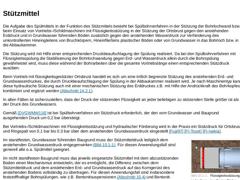
|
Die Aufgabe des Spülmittels in der Funktion des Stützmittels besteht bei Spülbohrverfahren in der Stützung der Bohrlochwand bzw. beim Einsatz von Vortriebs-/Schildmaschinen mit Flüssigkeitsstützung in der Stützung der Ortsbrust gegen den anstehenden Erddruck und in Grundwasser führenden Böden zusätzlich gegen den anstehenden Wasserdruck zur Verhinderung des unkontrollierten Hineingleitens von Bruchkörpern, Hineinfließens plastischer Böden oder von … |

|
Die Aufgabe des Spülmittels in der Funktion des Fördermittels besteht (Tabelle 10) : - beim Spülbohrverfahren darin, das Bohrwerkzeug und das Bohrloch vom gelösten Bohrklein freizuhalten und dieses durch den Ringraum zwischen Bohrgestänge und Bohrlochwand (direkte Spülbohrverfahren) oder durch das Innere des Bohrgestänges (indirekte Spülbohrverfahren) hydraulisch nach über Tage zu transportieren, und
- beim Mikrotunnelbau mit hydraulischer Förderung …
|
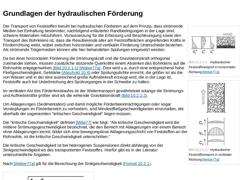
|
| (Bild: Hydraulischer Feststofftransport in horizontaler Richtung [Weber77a]) |
| (Bild: Hydraulischer Feststofftransport in vertikaler Richtung [Weber77a]) |
Der Transport von Feststoffen beruht bei hydraulischen Förderern auf dem Prinzip, dass strömende Medien bei Einhaltung bestimmter, nachfolgend erläuterter Randbedingungen in der Lage sind, schwere Materialien mitzuführen. Voraussetzung für die Erfassung und Beschleunigung sowie den Transport des … |
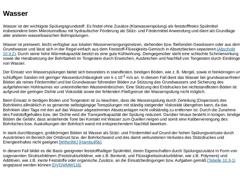
|
Wasser ist der wichtigste Spülungsgrundstoff. Es findet ohne Zusätze (Klarwasserspülung) als feststofffreies Spülmittel insbesondere beim Mikrotunnelbau mit hydraulischer Förderung als Stütz- und Fördermittel Anwendung und dient als Grundlage aller anderen wasserbasischen Bohrspülungen.
Wasser ist preiswert, leicht verfügbar aus lokalen Wasserversorgungsnetzen, stehenden bzw. fließenden Gewässern oder aus dem Grundwasser und lässt sich in der Regel … |

|
Zu den wichtigsten Feststrukturbildnern im Zusammenhang mit Spülmitteln zählt Bentonit. Der natürlich vorkommende, quellfähige Ton wurde zuerst 1898 bei Fort Benton in Wyoming, USA, entdeckt.
Den Hauptbestandteil von Bentonit bildet das Tonmineral Montmorillonit, ein schichtweise gelagertes Aluminiumhydrosilikat, welches weitgehend die physikalischen und chemischen Eigenschaften des Bentonits bestimmt [Hofma56] [Bento] [Jasmu93].
Die Lagerstätten …
|
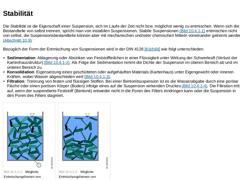
|
Die Stabilität ist die Eigenschaft einer Suspension, sich im Laufe der Zeit nicht bzw. möglichst wenig zu entmischen. Wenn sich die Bestandteile von selbst trennen, spricht man von instabilen Suspensionen. Stabile Suspensionen (Bild 10.4.1) entmischen nicht von selbst, die Suspensionsbestandteile können aber mit mechanischen und/oder chemischen Mitteln voneinander getrennt werden (Abschnitt 10.9).
Bezüglich der Form der Entmischung von Suspensionen …
|

|
Die Dichte ρ ist als physikalische Größe definiert als das Verhältnis der Masse m eines Stoffes zu seinem Volumen V. Sie bestimmt im vorliegenden Anwendungsfall zusammen mit der Viskosität und der Fließgeschwindigkeit die mögliche Transportkapazität der Spülung (Abschnitt 10.8.3).
Ihre Bestimmung erfolgt mit Hilfe einer sogenannten Spülungswaage oder durch Wiegen eines bekannten Volumens. Nach letzterer Methode berechnet sich die Dichte mit Hilfe … |

|
Unter Viskosität η versteht man die Zähigkeit von Flüssigkeiten, die durch die innere Reibung, die benachbarte Flüssigkeitsschichten aufeinander ausüben, weil ihre Moleküle sich gegenseitig anziehen, verursacht wird.
Nach DIN 1342-2 [DIN1342a] ist Viskosität das Verhältnis zwischen Schubspannung τ und Geschwindigkeitsgefälle D innerhalb einer ebenen geradlinigen Parallelströmung zwischen zwei benachbarten Flüssigkeitsschichten (Scherströmung) (Formel … |

|
Als Fließgrenze τF eines Stoffes wird seine Eigenschaft bezeichnet, Schubspannungen τ bis zu einer maximalen Größe aufnehmen zu können, ohne dass plastische Deformationen (Fließen) eintreten.
Für einen ideal plastischen Stoff bzw. eine ideal plastische Flüssigkeit gilt [Walz01] : - für τ < τF
keine plastische Deformation
- für τ = τF
unbeschränkte plastische Deformation (Fließen)
(Bild: Thixotrope Verfestigung [DIN4127])
Die Fließgrenze τF ist gemäß …
|

|
Bentonitsuspensionen kommen in grobkörnigen, locker bis dicht gelagerten Sanden oder Kiesen, ungleichförmigen und inhomogenen Böden mit Wasserdurchlässigkeitsbeiwerten k > 10-3 m/s zur Anwendung [DVGWMW116] [Wilhe99c] [Prems98].
Reine Bentonitspülungen finden ihre Anwendungsgrenzen einerseits in grobkörnigen Böden mit offenen Strukturen, wie z.B. gleichförmige Grobkiese, und andererseits in reinen tonigen Böden. Bei letzteren findet infolge fehlender … |

|
Polymerspülungen sind wasserbasische Spülungen, denen so genannte Flüssigkeitsstrukturbildner in Form von stark wasserbindenden Polymeren zugefügt werden.
Polymere sind chemische Verbindungen, bei denen eine Vielzahl gleicher oder gleichartiger Grundmoleküle miteinander fest verbunden sind. Sie entstehen durch eine geordnete Verknüpfung der Einzelmoleküle (Monomere) zu einem Ketten- bzw. Makromolekül (Polymerisation). Die wichtigste Bindungsart …
|
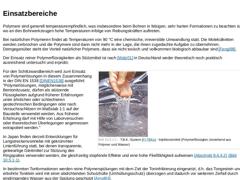
|
Polymere sind generell temperaturempfindlich, was insbesondere beim Bohren in felsigen, sehr harten Formationen zu beachten ist, wo an den Bohrwerkzeugen hohe Temperaturen infolge von Reibungskräften auftreten.
Bei natürlichen Polymeren findet ab Temperaturen von 90 °C eine chemische, irreversible Umwandlung statt. Die Molekülketten werden zerbrochen und die Polymere sind dann nicht mehr in der Lage, die ihnen zugedachte Aufgabe zu übernehmen. …
|
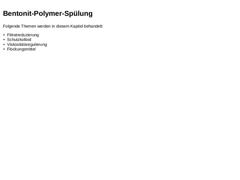
|
Bentonit-Polymer-Spülungen bestehen aus Wasser als Grundstoff, dem Bentonit und Polymere zugegeben werden. Sie werden bevorzugt in grobkörnigen Böden mit offenen Strukturen, wie z.B. gleichförmige Grobkiese, zur Vermeidung von Ausströmungen eingesetzt. Sie besitzen eine reibungsreduzierende und viskositätserhöhende Wirkung, wodurch eine Verbesserung der Bohrbarkeit erzielt wird und geringere Fließgeschwindigkeiten z.B. bei Spülbohrverfahren mit … |

|
Unter Filtratreduzierung von Bohrspülungen versteht man die Verminderung der in das Gebirge abfiltrierenden Flüssigkeitsmenge, die Filtratverluste, durch die Ausbildung eines möglichst dünnen, dichten, zähen und elastisch abdichtenden Filterkuchens [Arnol93].
Um diese Filtratreduzierung zu erreichen, werden so genannte Filtratsenker auf der Basis von Polymeren eingesetzt. Sie bestehen aus Makromolekülen, die sich infolge der großen Anzahl an negativen … |
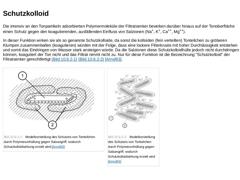
|
Die intensiv an den Tonpartikeln adsorbierten Polymermoleküle der Filtratsenker bewirken darüber hinaus auf der Tonoberfläche einen Schutz gegen den koagulierenden, ausfällenden Einfluss von Salzionen (Na+, K+, Ca++, Mg++).
In dieser Funktion wirken sie als so genannte Schutzkolloide, da sonst die kolloiden (fein verteilten) Tonteilchen zu gröberen Klumpen zusammenballen (koagulieren) würden mit der Folge, dass eine lockere Filterkruste mit hoher … |

|
Die Viskositätsregulierung dient der Senkung der Viskosität. Dies ist vor allem dann erforderlich, wenn die Spülung durch die Aufnahme von Feinstfeststoffen aus dem Bohrklein oder durch Laugenzuflüsse aus dem Grundwasser beginnt einzudicken (z.B. durch Tonbohrklein verdickte Spülungen).
Die einfachste Methode zur Senkung der Viskosität der Spülung stellt die Zugabe von Wasser dar. Wenn die erhöhte Viskosität nicht durch Wasserzugabe gesenkt werden … |
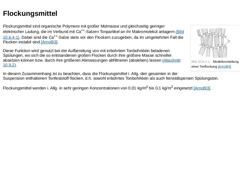
|
(Bild: Modellvorstellung einer Tonflockung [Arnol93])
Flockungsmittel sind organische Polymere mit großer Molmasse und gleichzeitig geringer elektrischer Ladung, die im Verbund mit Ca++-Salzen Tonpartikel an ihr Makromolekül anlagern (Bild 10.6.4). Dabei sind die Ca++-Salze stets vor den Flockern zuzugeben, da im umgekehrten Fall die Flocken instabil sind [Arnol93].
Diese Funktion wird genutzt bei der Aufbereitung von mit erbohrtem Tonbohrklein … |

|
Zur gezielten Beeinflussung der Bohrspülung können sowohl chemisch aktive als auch chemisch nicht aktive Additive hinzugefügt werden.
Chemisch wirksame Additive, nach DIN V 4126-100 [DINV4126-100] auch als Zusatzmittel bezeichnet, werden der Spülung mit dem Ziel beigegeben, deren mechanische Eigenschaften insbesondere das Fließ-, Eindring- und Stabilitätsverhalten zu verändern. Zu den Zusatzmitteln zählen z.B. Filtratsenker (Abschnitt 10.6.1), … |

|
Inerte Feststoffe werden als reaktionsträge Stoffe bezeichnet. Sie beteiligen sich nicht oder nur teilweise an den chemischen Vorgängen in den Spülungen und werden nach ihrer Herkunft sowie Art der Nutzung unterschieden in: - Stopfmittel (Abschnitt 10.7.1.1) und
- Beschwerungsstoffe (Abschnitt 10.7.1.2)
|

|
Stopfmittel werden zur Bekämpfung von Spülungsverlusten eingesetzt, um durch ihre Menge, Größe und Form der Partikel Porenräume, Risse und Klüfte zu verschließen. Eine wesentliche Rolle spielen der Durchmesser des Stopfmittels und die Korngrößenverteilung. Klüftigkeiten z.B. erfordern zum Verstopfen ein Material, das in seinem Durchmesser mindestens 1/3 der Kluftbreite entspricht [Fengl98].
Stopfmittel sollten möglichst faserförmig sein, im Wasser … |

|
Beschwerungsstoffe werden zur Erhöhung der Dichte und damit des statischen Druckes von Spülungen, insbesondere beim Auftreten von artesisch gespanntem Grundwasser, eingesetzt.
Für ihre Auswahl sind im wesentlichen folgende Punkte entscheidend: - Dichte des Stoffes
- Korngrößenverteilung
- Verunreinigungen des Stoffes
Beim Einsatz von Beschwerungsstoffen ist zu beachten, dass sie zum einen die Ursache eines erhöhten Verschleißes an der Düsengeometrie … |

|
Einer Bohrspülung können im spezifischen Einsatzfall z.B. folgende anorganische Zusatzmittel beigemischt werden [Arnol93] :
Alkalien, wie z.B. Soda (Na2CO3), Pottasche (K2CO3) oder Löschkalk (Ca(OH)2), haben folgende Aufgaben [Arnol93] : - Einstellung des optimalen pH-Wertes von 8 bis 10 für Bentonitspülungen auch beim Einsatz von Filtratsenkern
- Anheben der Viskosität von Tonspülungen
- Minimierung der Korrosion von Stahl
|

|
|